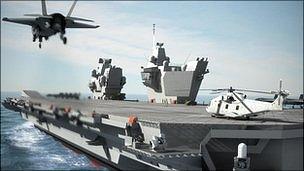Defence cuts: Carrier 'fully operational in 2030'
- Published
- comments

HMS Queen Elizabeth and HMS Prince of Wales are being built, but one will be mothballed
Britain may be without a fully operational aircraft carrier until 2030, according to a report published by the Commons spending watchdog.
The public accounts committee said two carriers being built would cost more, offer less military capability and be ready much later than planned.
It said the Royal Navy would be without a carrier until 2020.
The MoD said carrier-based joint strike fighter capability would begin in 2020 and increase over subsequent years.
The public accounts committee also said the cost of scaling back the carriers was not fully known.
The government says it expects to save £4.4bn over 10 years on the programme.
But the committee's Labour chairman Margaret Hodge said the final cost could end up being £12bn over budget.
"Whilst today we're reporting predicted costs for this of £6.2bn, my fear is that that's not the end of the story," she said.
"Indeed one insider said to me that the cost could escalate up to an amazing £12bn for this project."
The ships - HMS Queen Elizabeth and HMS Prince of Wales which were to be based in Portsmouth - were saved from defence cuts under the coalition government because, it said, it would cost more to cancel the projects than proceed with them.
Over budget
In last year's strategic defence review, ministers agreed to change the design of one, or both, of the aircraft carriers to make them compatible with the US Navy's version of the Joint Strike Fighter, rather than the short take-off, vertical-landing (STOVL) version that had been planned.
HMS Prince of Wales will be mothballed and kept as a reserve vessel - while HMS Queen Elizabeth is expected to go into service around 2020, with both said to cost £5.9bn.
The government said the two carriers were already £1.6bn over budget when it came to power - and that changes in the defence review reduced overall spending on the "carrier strike programme" by £4.4bn over 10 years.
But the committee disagreed, saying the government concentrated on immediate cash savings and not on long-term value for money.
"Changes to the aircraft carriers and the aircraft flying from them in the 2010 Strategic Defence and Security Review have changed the risks and costs involved in ways that are not fully understood," said Mrs Hodge.
"Rather than two carriers, available from 2016 and 2018, at a cost of £3.65 billion, we will now spend more than £6bn, get one operational carrier and have no aircraft carrier capability until 2020 - almost a decade."
The report also said there is "considerable uncertainty" about the costs of modifying one of the carriers to accommodate a different type of fighter jet - and the full costs would not be known until December 2012.
'Gaping hole'
While the change had reduced the technical risks associated with the STOVL aircraft - the fact that its full costs would not be known for another year left the project "at risk of cost growth and slippage", the report said.
And it added there were other technical risks associated with integrating new aircraft with the carriers and suggested full carrier strike capability might not be achieved until 2030.
Labour said the report showed there was a "gaping hole" in the government's credibility on defence.
Shadow defence secretary Jim Murphy said: "It is high time ministers took responsibility for their actions. The rushed, Treasury-driven defence review left Britain without aircraft flying from an aircraft carrier for a decade."
But Defence Secretary Philip Hammond said the government was trying to get the MoD's finances "back into balance" having inherited a "black hole" from Labour.
He stressed the two aircraft carriers were already £1.6bn over budget when the coalition came to power - and said government spending cuts would save £4.4bn over 10 years on the carrier strike programme.
"The National Audit Office and the Public Accounts Committee have both acknowledged that our decision to build a second aircraft carrier makes financial sense, he said.
"Converting one of the Queen Elizabeth Class aircraft carriers to operate the more capable carrier variant of the Joint Strike Fighter fast jet from 2020 will maximise our military capability and enhance inter-operability with our allies.
"Operating the more cost effective carrier variant fast jet will, in the long-term, offset the conversion costs and provide us with aircraft that have a longer range and carry a greater payload."
He added that the Libya campaign had showed how Britain could use its bases and over-flight rights to "project decisive air power", before its new aircraft carrier capability came into service.
An MoD spokeswoman said: "It is incorrect to claim that a full carrier strike capability will not be achieved until 2030.
"The more capable carrier variant of the joint strike fighter fast jet will begin operating from our aircraft carrier from 2020, with six UK jets available for operations.
"By 2023, this number will increase to 12 UK jets onboard and we will be able to work with our allies to increase that number because of the interoperability that the carrier variant joint strike fighter allows."
- Published7 April 2011
- Published7 July 2011
- Published16 November 2011
- Published1 September 2011
- Published4 June 2011